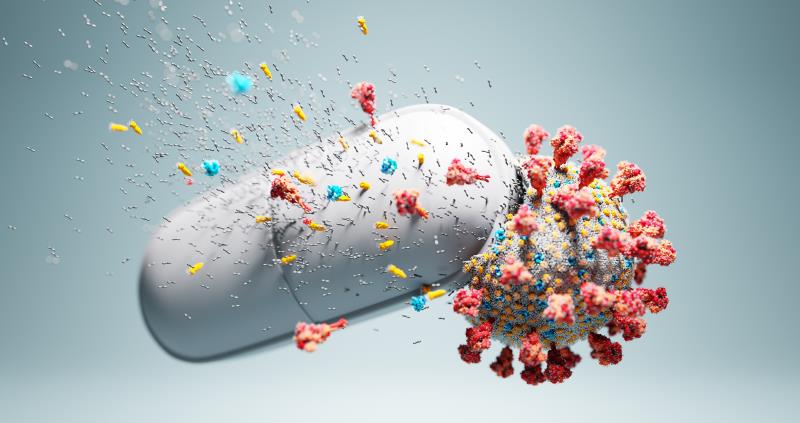Ensitrelvir a viable alternative to available antivirals for COVID-19





The investigational oral antiviral ensitrelvir shows potent antiviral activity in COVID-19, although its effect is slightly weaker than that of ritonavir-boosted nirmatrelvir, according to the ongoing, phase II, randomized controlled, adaptive pharmacometric platform PLATCOV trial.
Over 5 days of treatment, the primary endpoint of SARS-CoV-2 clearance with ensitrelvir was 82 percent faster (95 percent credible interval [CrI], 61–104) compared with no treatment but 16 percent slower (95 percent CrI, 5–25) compared with ritonavir-boosted nirmatrelvir. [Lancet Infect Dis 2025;doi:10.1016/S1473-3099(25)00482-7]
Treatment with ensitrelvir and ritonavir-boosted nirmatrelvir reduced the median estimated SARS-CoV-2 clearance half-lives from 11.6 h to 5.9 and 5.2 h, respectively. By day 3, the median viral densities were 2.9-fold lower with ensitrelvir and 2.4-fold lower with ritonavir-boosted nirmatrelvir vs no treatment.
In a meta-analysis involving 1,157 patients, ensitrelvir was found to have greater potency than all the other small-molecule drugs evaluated in the trial (ie, ivermectin, favipiravir, remdesivir, molnupiravir) apart from ritonavir-boosted nirmatrelvir. In the overall comparison, ensitrelvir accelerated viral clearance relative to no treatment by 87 percent (95 percent CrI, 68–111), while ritonavir-boosted nirmatrelvir did so by 126 percent (95 percent CrI, 105–151).
Safety and viral rebound
“Both ritonavir-boosted nirmatrelvir and ensitrelvir resulted in few discontinuations, although more than 25 percent of the patients who received ritonavir-boosted nirmatrelvir actively complained of dysgeusia,” the investigators noted.
Two patients in the ritonavir-boosted nirmatrelvir arm discontinued treatment due to interactions with concomitant drugs. Dysgeusia was reported in 26 percent of patients in the ritonavir-boosted nirmatrelvir arm, 1 percent in the ensitrelvir arm, and 1 percent in the no-treatment arm.
“There were no clear differences in clinical responses and, although there were slightly fewer viral rebounds in the ensitrelvir group, the overall number of rebounds under our definition was low,” the investigators said.
Viral rebound occurred in 7 percent of patients in the ritonavir-boosted nirmatrelvir arm, 5 percent in the ensitrelvir group, and 7 percent in the no-treatment arm. The median time to viral rebound was 9.9, 5.9, and 6.9 days in the respective treatment arms.
Describing the implications of their findings, the investigators emphasized that “ensitrelvir can be considered an efficacious and well-tolerated alternative to available antivirals.”
Favourable alternative
In a linked editorial, Drs Choi Ming Hong and Ivan Hung both from the University of Hong Kong in Hong Kong Special Administrative Region, China, echoed the investigators, noting that the reported efficacy and safety profile of ensitrelvir makes it a “valuable and much-needed alternative” in the COVID-19 therapy, “although ritonavir-boosted nirmatrelvir remains the standard of care for high-risk outpatients.” [Lancet Infect Dis 2025;doi:10.1016/S1473-3099(25)00549-3]
Hong and Hung highlighted the clinical importance of the safety findings, pointing out that ensitrelvir, which did not induce dysgeusia, could improve patient adherence and acceptance. “This is particularly relevant given that the unpleasant taste associated with ritonavir-boosted nirmatrelvir has been cited as a reason for treatment discontinuation.”
However, it remains uncertain if this accelerated viral clearance with ensitrelvir translates to reduced hospitalizations, mortality, or symptom burden, particularly in vaccinated and low-risk populations, they said.
PLATCOV trial
The analysis included 604 low-risk adult outpatients ages 18–60 years who had early symptomatic COVID-19 (<4 days of symptoms) recruited from clinics in Thailand and Laos. These patients were randomly allocated to the ensitrelvir (n=202), ritonavir-boosted nirmatrelvir (n=207), or no-treatment (n=195) arm. Ensitrelvir and ritonavir-boosted nirmatrelvir were administered at standard doses for 5 days.
All patients underwent four oropharyngeal swabs taken on day 0 and two swabs taken daily from days 1 to 7, then on days 10 and 14. The primary endpoint of oropharyngeal SARS-CoV-2 viral clearance rate was assessed between day 0 and day 5 among patients with at least 2 days of follow-up. Published results were used for the individual patient data meta-analysis.
None of the patients developed severe disease, although seven patients were hospitalized (n=2 in the ensitrelvir arm, n=3 in the ritonavir-boosted nirmatrelvir arm, and n=2 in the no-treatment arm). One patient each in the ritonavir-boosted nirmatrelvir and no-treatment arms reported fatigue related to COVID-19.
The mean durations of fever did not significantly differ across the treatment arms (1.2 days in the active treatment arms and 1.4 days in the no-treatment arm). The restricted mean duration of symptoms over 1 week was 5.4 days both in the ensitrelvir and ritonavir-boosted nirmatrelvir arms and 5.9 days in the no-treatment arm.